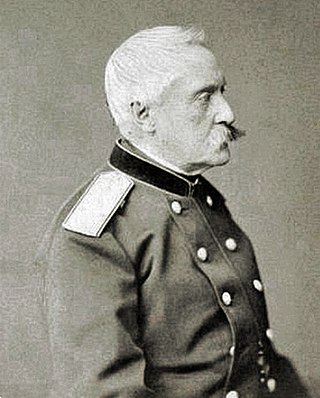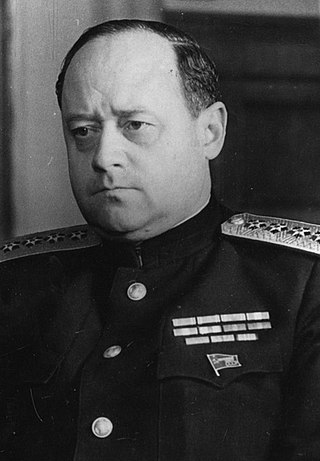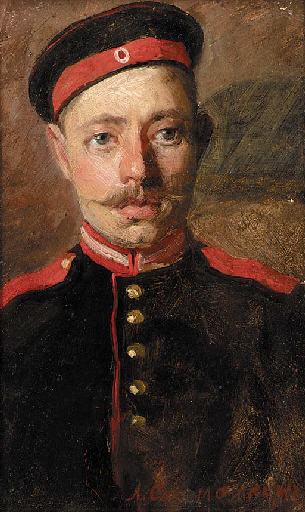
Alexander Petrovich Karpinsky was a prominent Russian and Soviet geologist and mineralogist, and the president of the Russian Academy of Sciences, and later Academy of Sciences of the USSR, in 1917–1936.

Friedrich Benjamin Graf von Lütke, more commonly known by his Russian name Fyodor Litke, was a Russian navigator, geographer, and Arctic explorer. He became a count in 1866, and an admiral in 1855. He was a corresponding member (1829), Honorable Member (1855), and President (1864) of the Russian Academy of Science in St. Petersburg. He was also an Honorable Member of many other Russian and foreign scientific establishments, and a corresponding member of the French Academy of Science in Paris.

Baron Ferdinand Friedrich Georg Ludwig von Wrangel was a Russia German explorer and officer in the Imperial Russian Navy, Honorable Member of the Saint Petersburg Academy of Sciences, and a founder of the Russian Geographic Society. He is best known as the chief manager of the Russian-American Company and governor of the Russian settlements in present-day Alaska.

Admiral Mikhail Petrovich Lazarev was a Russian fleet commander and an explorer.

Gregor von Helmersen or Grigory Petrovich Helmersen was a Baltic German geologist.

Ivan Petrovich Martos was a Russian sculptor and art teacher of Ukrainian origin who helped awaken Russian interest in Neoclassical sculpture.

Ivan Petrovich Argunov was a Russian painter, one of the founders of the Russian school of portrait painting.

Ivan Stepanovich Isakov, born Hovhannes Ter-Isahakyan, was a Soviet Armenian military commander, Chief of Staff of the Soviet Navy, Deputy USSR Navy Minister, and held the rank of Admiral of the Fleet of the Soviet Union. He played a crucial role in shaping the Soviet Navy, particularly the Baltic and Black Sea flotillas during the Second World War. Aside from his military career, Isakov became a member and writer of the oceanographic committee of the Soviet Union Academy of Sciences in 1958 and, in 1967, became an honorary member of the Armenian Soviet Socialist Republic's Academy of Sciences.

Patriarch Joachim was the eleventh Patriarch of Moscow and All Russia, an opponent of the Raskol, and a founder of the Slavic Greek Latin Academy.

Ivan Petrovich Trutnev was a Russian painter and art teacher.

Ivan Petrovich Liprandi was a Russian secret service officer, major general, and memoirist of Spanish and Italian descent. He was the elder brother of Pavel Liprandi.

Ivan Petrovich Vitali was a Russian sculptor of Italian descent. Born in Saint Petersburg, he was apprenticed to his father, Pietro Vitali, from an early age. After attending the Imperial Academy of Arts he moved to Moscow in 1818. His major works include a six-horse chariot for Bove's Triumphal Arch, a fountain in front of the Bolshoi Theatre (1825), the bas-reliefs above the doors of St. Isaac's Cathedral, and an outdoor bronze statue of Emperor Paul in Gatchina.

Adam Johann von Krusenstern was a Russian admiral and explorer of Baltic German descent, who led the first Russian circumnavigation of the Earth in 1803–1806.

Peter Johann Christoph Graf von der Pahlen was a Baltic German aristocrat and a general of the Imperial Russian Army.

Ivan Petrovich Sakharov was a Russian folklorist, ethnographer, archeologist and paleographer.
Grigory Petrovich Kireyev was a high-ranking commander in the Soviet Navy. He rose to command the Soviet Pacific Fleet in 1937. Kireyev was executed in 1938 during the Great Purge.
Giovanni Battista Belli-Bernasconi was a Russian architect born in Switzerland. He was the author of many classical buildings and architectural ensembles in Saint Petersburg and its surroundings.

Ivan Petrovich Bogdanov was a Russian Empire and later Soviet painter.
Ivan Petrovich Antonov was a sniper in the Red Navy who killed over 300 enemy soldiers between 1941 and 1942, for which he was awarded the title Hero of the Soviet Union.















